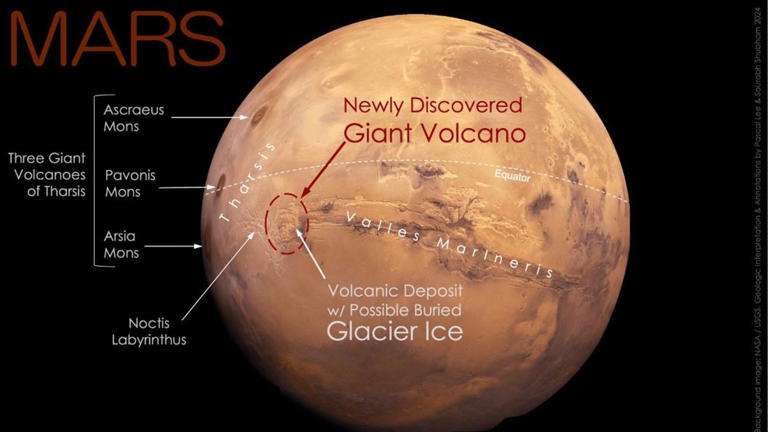Vast underground water reservoirs on Mars have been discovered, providing new insights into the planet’s history and potential for future exploration. Learn about the latest findings and their implications for Mars exploration.

© Provided by Indy 100
Vast Underground Water Reservoirs on Mars: A New Discovery
In a groundbreaking discovery, scientists have found evidence of vast underground water reservoirs on Mars. This revelation, based on data from NASA’s InSight lander, suggests that large quantities of liquid water are hidden beneath the Martian surface, possibly enough to create oceans on the planet.
The Significance of Water on Mars
Water has always been a key focus in the search for life beyond Earth. The discovery of vast underground water reservoirs on Mars could be a major breakthrough in understanding the planet’s past and its potential to support life. For years, scientists have been intrigued by the possibility of water existing on Mars, and this new evidence could reshape our understanding of the Martian environment.
How the Discovery Was Made
The discovery of these vast underground water reservoirs on Mars was made possible by the InSight lander, which NASA sent to Mars to study the planet’s interior. InSight’s mission, which lasted four years and concluded in 2022, gathered critical data that helped scientists understand what lies beneath the surface of Mars.
One of InSight’s primary tools was its ability to measure Marsquakes—similar to earthquakes on Earth. By analyzing the waves generated by these quakes, scientists could infer the composition and structure of the Martian crust. Using a model based on rock physics, researchers determined that the data collected by InSight is most plausibly explained by the presence of liquid water within the planet’s crust.
Vast Underground Water Reservoirs on Mars: How Much Water is There?
The most striking aspect of this discovery is the sheer volume of water that could be present. Scientists estimate that if all the groundwater were to rise to the surface, it could cover Mars with a layer of water between one and two kilometers deep. This would be enough water to create vast oceans, completely transforming the planet’s landscape.
However, this water is not easily accessible. The vast underground water reservoirs on Mars are believed to be trapped in tiny cracks and pores within the rock, buried between 11.5 and 20 kilometers below the surface. On Earth, drilling to such depths is an immense challenge, and on Mars, it would be even more difficult due to the planet’s harsh environment and the technological limitations of current exploration tools.
The Implications for Mars Exploration
The discovery of vast underground water reservoirs on Mars has significant implications for future Mars exploration. Understanding where water is located and how much is available is crucial for any potential human missions to Mars. Water is a vital resource for sustaining life, and it could also be used to produce fuel and oxygen for astronauts.
However, accessing this water would require advanced drilling technology and a thorough understanding of the Martian crust. Currently, the depth at which this water is located makes it challenging to tap into. This raises questions about the feasibility of using these water reservoirs to support future Mars colonies.
What Does This Mean for the Search for Life?
The presence of vast underground water reservoirs on Mars also has profound implications for the search for life. Water is essential for life as we know it, and its presence on Mars increases the possibility that the planet could have supported life in the past—or might even support microbial life today.
Scientists believe that Mars once had large amounts of surface water billions of years ago. Understanding what happened to this water is key to unraveling the planet’s history. The discovery that much of the water may have seeped into the crust rather than escaping into space offers new clues about the planet’s climatic and geological evolution.
Challenges in Accessing the Water
While the discovery of vast underground water reservoirs on Mars is exciting, it also presents significant challenges. The water is located deep within the Martian crust, making it difficult to access with current technology. Drilling to such depths would require significant advancements in robotic and human exploration capabilities.
Moreover, the water is not in large, easily accessible lakes or rivers; it is trapped in the rock, which complicates the process of extracting it. Even on Earth, drilling to similar depths is a complex and expensive endeavor. On Mars, it would be even more challenging due to the planet’s lower gravity, harsh environment, and the logistical difficulties of remote exploration.
Future Prospects and Research
The discovery of vast underground water reservoirs on Mars opens new avenues for research and exploration. Future missions to Mars could focus on developing the technology needed to access this water. Additionally, more research is needed to determine the exact composition and distribution of the water within the Martian crust.
Understanding the mineralogy and composition of Mars’ crust is crucial for developing effective strategies to access the water. The data collected by InSight provides a valuable starting point, but more detailed studies are needed to refine our understanding of the planet’s subsurface.
Conclusion
The discovery of vast underground water reservoirs on Mars is a significant milestone in our exploration of the red planet. While the water may be difficult to access, its presence offers new insights into Mars’ history and its potential to support life. As we continue to explore Mars, the knowledge gained from these findings will be essential in planning future missions and understanding the planet’s mysteries.
Vast underground water reservoirs on Mars could hold the key to unlocking the planet’s past and its potential for future human exploration. With ongoing research and advancements in technology, we may one day be able to tap into these hidden resources and use them to support life on Mars.
ALSO READ: